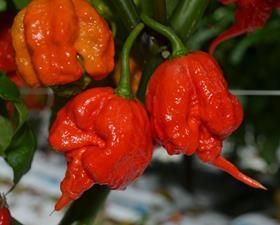
One of the earliest English accounts of the chilli came from the botanist John Gerard in 1597, who recorded “it hath in it a malicious quality”, noting also that “it killeth dogs”. Indeed, British tastes took a long time to acclimatise to the South American discovery, and for some enthusiasts we are still playing catch-up.
According to Kantar Worldpanel data, supermarket chilli sales in the UK have grown by nearly 25 per cent in the past five years. In the year up to March 2018, shoppers splashed out just over £20 million on chillies, compared to £15m in March 2014. For a greater comparison, total sales of chillies ten years ago was £9m. Noticeably, exotic chillies have emerged as the fastest-growing category, nearly tripling their spend since 2014.
Their retail popularity is reflected in a burgeoning British chilli scene, with combined growing and processing operations pushing out hotter and hotter sauces at festivals, food markets and niche shops across the UK.
“If you go back 15 years, there was nothing more than Tabasco,” recalls Martin Bond, of Wiltshire Chilli Farm. “And if you look at supermarkets, there’s still not a huge amount of hot sauce selection.” A cursory browse of their aisles confirms his observation, with the usual bottles of McIlhenny’s, Cholula and Encona on display, arguably behind the public‘s widening palette.
Damian Fowler, director at New Covent Garden Market wholesalers Gilgrove attributes their growth to an increasing adventurousness driven by television, helped along by restaurant sales.
“More people are eating out, it’s an eating out kind of food. The amount of cooking programmes on TV too mean that people are looking for something more experimental, with new flavours, being more adventurous in their own cooking because they are being influenced by what they see,” he says.
Bond adds that the Asian influence on British cuisine has paved the way for hotter flavours. “As a nation we are big fans of Indian food – we can handle the heat. We don’t sell much in France – they have got a lot of rich food, but no spicy food. The French public don’t really want it.”
It’s in the exotic category that one finds the kind of varieties where pain becomes part of the game, boasting appetizing names like Carolina Reaper, Naga Viper and Pepper X.
Tesco has been brave in offering these eccentric products, selling some of the spiciest raw chillies going, mostly garnered from the UK’s largest chilli farmer Salvatore Genovese. “Since 2015 we have launched varieties including Carolina Reaper, Komodo Dragon and jalapeños, which have all been really popular with customers. Chilli plants are also becoming popular,” says Tesco chilli buyer Shubham Arora.
But sauces and processed chillies lag behind, and to be fair to retailers, past experience of playing with fire has not always proved successful. According to Bond, Tesco was stung after sales of an early super-hot sauce brand fell flat. “About four to five years ago Tesco tried Dave’s Insanity Sauce. The problem was it was incredibly spicy but it doesn’t have a lot of flavour,” says Bond.
As Arora says, planted chilli pots have also helped push sales, becoming popular in households, although Spanish imports have slowed down UK output of potted chillies, according to grower Joe Johnson. “By the time you purchase them all the leaves have fallen off. We’ve seen our chilli pot sales go down,” Johnson says.
But Bond thinks retailers won’t tap into the processed chilli scene until it becomes economically viable for both parties. “There’s plenty more work to be done in the UK, but until supermarkets are willing to charge £4 for a 100ml bottle in their shelves, demand for our kind of sauces will remain in farmers’ markets, shops and food festivals.”



